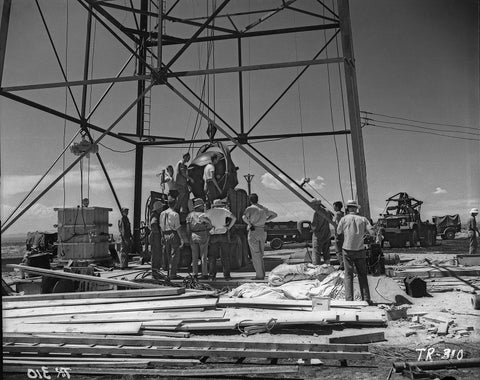Trinity
Questions for Reflection
- How did the Trinity test mark a significant turning point in human history?
- What were the motivations and goals behind the development of the atomic bomb during the Manhattan Project?
- How did the Trinity test impact scientific understanding and technological advancements in the field of nuclear physics?
- What ethical considerations and moral dilemmas arise from the creation and use of such a powerful weapon?
- In what ways did the Trinity test shape global politics and the arms race during the Cold War era?
Many Manhattan Project employees would become Nobel Prize recipients, including Richard Feynman and Luis Alvarez. Albert Einstein, whose warning to FDR was partly responsible for instigating the Manhattan project, had doubts later in life whether this action was proper. A few days before his death in 1955, Einstein signed the Russell-Einstein Manifesto with philosopher Bertrand Russel and nine other famous intellectuals warning about the dangers of nuclear weapons as the Cold War escalated.
Debates about the Manhattan project and the bombing of Japan continue to this day. Opponents point out the massive amounts of civilian deaths and the nuclear arms race that continued for decades into the Cold War.
Media Gallery

The Gadget explodes, forming a distinctive mushroom cloud, with an approximate explosive power equal to 25 kilotons of TNT.

The obelisk at the Trinity Site.

Trinity site map

The red arrow points at Trinity site near Carrizozo Malpais

The base camp at the Trinity test site. The base camp is near a bombing range and experienced accidental bombing twice. During a practice night raid, the lead plane unintentionally disrupted the lights that were illuminating their intended target, causing them to mistakenly bomb the Trinity base camp.

Jumbo is on the way to the site.
Robert W. Henderson and Roy W. Carlson from the X-2A Section at Los Alamos Laboratory were tasked with designing a containment vessel named "Jumbo" for an unsuccessful explosion. The purpose of Jumbo was to encase the bomb, so that if its detonation failed, the outer walls of Jumbo would remain intact, allowing for the retrieval of the bomb's plutonium.

In order to prioritize the collection of accurate explosion data, it was determined that utilizing Jumbo would impede this primary objective of the test. Consequently, the decision was made not to deploy it. Instead, Jumbo was raised on a steel tower located 800 yards (732 m) away from the explosion site, preserving it for a future test. Ultimately, while Jumbo withstood the explosion, its accompanying tower did not.

Men carefully arrange crates containing a significant quantity of high explosives for the 100-ton test.

A replica of the Gadget physics package is displayed at the Nuclear Weapons Instructional Museum located at Kirtland Air Force Base.

The fundamental nuclear elements of the Gadget were assembled, with the insertion of the uranium slug containing the plutonium sphere taking place towards the end of the assembly process.

Louis Slotin and Herbert Lehr pictured with the Gadget before the tamper plug was inserted (visible in front of Lehr's left knee)

The test featured the construction of a 30-meter (100 ft) "shot tower."

The final assembly of the Gadget takes place as it is unloaded at the base of the tower.

A detailed view capturing the detonation of the Gadget device and the ensuing fireball, estimated to have a yield of 25 kilotons of TNT.

As a result of the intense heat, the sandy desert terrain underwent a transformation, with the silica-rich sand melting and forming a lightly radioactive glass known as trinitite.

This is an authentic color-exposed photograph captured by Jack Aeby on July 16, 1945.

Ground zero. Photo of test site after the experiment.

The image captures the Trinity explosion 25 milliseconds after detonation, with the peak of the fireball hemisphere reaching approximately 200 meters (660 feet) in height.

This aerial photograph captures the Trinity crater shortly after the test.

A few weeks later, Major General Leslie Groves and Robert Oppenheimer stand at the remains of the Trinity shot tower. They wear white overshoes to prevent the trinitite fallout from sticking to their shoe soles.
Replica source: Eyewitness Account of the Trinity Explosion, July 16, 1945, National Archives, Records of the Office of Scientific Research and Development, Record Group 227, National Archives Identifier 594933, https://catalog.archives.gov/id/594933
You may also like
National Parks Add-On Subscription
National Parks Add-On Subscription



Free subscription shipping in the US
U.S. Holidays Add-On Subscription
U.S. Holidays Add-On Subscription



Free subscription shipping in the US









